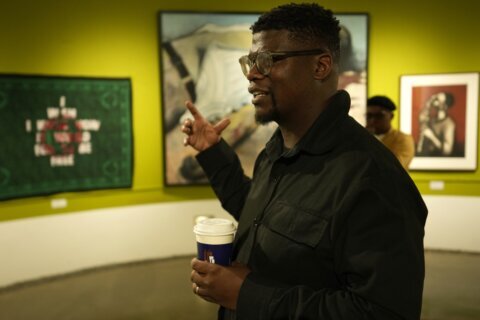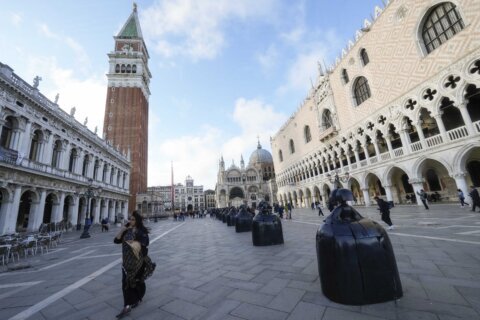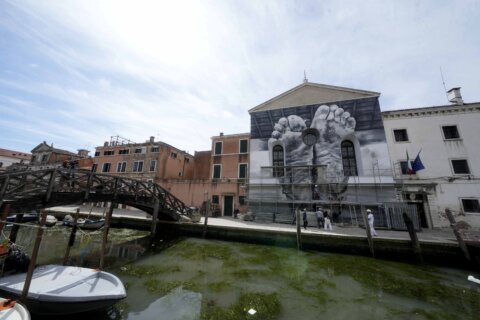SAN FRANCISCO (AP) — When composer John Adams decided to base his new work on Shakespeare’s “Antony and Cleopatra,” he was aware that the project might evoke an unhappy chapter in opera history.
Back in 1966, Samuel Barber had used the same play as his text when the Metropolitan Opera commissioned him to open its new home in Lincoln Center. That premiere was hobbled by an overly elaborate production and has gone down as one of the company’s more notorious flops.
“I knew that if my opera turned out to be a disappointment, it (the comparison to Barber) would be the lead in every criticism,” Adams said in an interview. “But that’s how much I wanted to do it: I didn’t care!”
Count Matthew Shilvock, the San Francisco Opera’s general director, as one who wasn’t worried. He had approached Adams to kick off the company’s 100th anniversary season with a new opera and said when he heard the proposal, “I felt he had such a personal, compelling passion for it that he was going to find a way to make it his own.”
Shilvock’s confidence in Adams’ ability to tackle Shakespeare was bolstered by the fact that he had set two speeches from “Macbeth” in his most recent opera, “Girls of the Golden West,” which premiered in San Francisco in 2017.
“I remember being so taken by those soliloquies and seeing how powerful those settings were,” he said.
For Adams, “Antony and Cleopatra” held special appeal because of the way Shakespeare combines the political story of the struggle for power in ancient Rome and Egypt with the passionate and often stormy relationship of two mature lovers.
“For all the pomp and pageantry and images of grandeur … this is basically a very intimate love story,” he said.
And as a man who recently turned 75, Adams said, “I can in certain ways identify with the crisis that Antony goes through. He’s uncertain of his powers, he doesn’t really know if what he can do now is as good as when he was 25 or 30. We all think about whether the mojo is still there.”
Once he had settled on the project, he enlisted director Elkhanah Pulitzer and dramaturg Lucia Scheckner to help boil down the sprawling text. They jettisoned many of the 42 characters and 40 scenes but also added a bit of material from other Shakespeare plays and a speech from Virgil’s “Aeneid” (in the English translation by John Dryden).
Setting theatrical dialogue to music presented Adams with an opportunity he had not enjoyed in his earlier operas. His first two — “Nixon in China” and “The Death of Klinghoffer” — had librettos by poet Alice Goodman that featured long speeches and meditations. In his subsequent collaborations with director Peter Sellars — from “Doctor Atomic” through “Girls” — the librettos were compiled entirely from “found texts” such as documents, diaries, speeches and poems.
“This is a very, very different vehicle for me,” Adams said, “because usually I’ve had big set pieces, big chunks of poetry. Here I wanted to write a very fast-moving drama set to music with characters who talk to each other.”
Pulitzer said she was inspired to see Adams taking on the challenge of setting one of the great masterpieces of English literature.
“There are modern slang words for how much gumption he had in tackling this,” she said. “He’s very bold, brave and truly an artist, always questing. He never really does the same thing twice.”
Part of Adams’ fascination for the characters was the way in which they consciously shape their own images, so much so that Cleopatra to this day remains the epitome of glamour in the public imagination. Pulitzer found a resonance in 1930s Hollywood, when the studios created stars who had a larger-than-life fascination for moviegoers.
The 1930s also saw the spread of fascism in Europe, and the production draws parallels between Octavius Caesar — Antony’s ascendant rival who later becomes emperor — and Benito Mussolini, the Italian dictator. At one point, a musical interlude depicting Antony’s marriage of convenience to Octavius’ sister is accompanied by archival footage of the wedding of Mussolini’s daughter Edda, complete with fascist salutes.
In keeping with the cinematic theme, the set by designer Mimi Lien is a movable frame made of wood and fabric that can shift to create apertures of varying sizes, somewhat like a movie camera.
“Antony and Cleopatra” opens Sept. 10 for a run of seven performances. It stars bass-baritone Gerald Finley as Antony, soprano Amina Edris as Cleopatra, tenor Paul Appleby as Caesar, bass-baritone Alfred Walker as Enobarbus and mezzo-soprano Elizabeth DeShong as Octavia. The company’s music director, Eun Sun Kim, will conduct. The production has been co-commissioned for future performances by Barcelona’s Liceu Opera, Palermo’s Teatro Massimo and the Met.
Finley, who also starred in “Doctor Atomic,” said he found the new opera “easier to learn and much more accessible” than some of Adams’ earlier work.
“You can’t help but get caught up in the drama because it really presses forward,” Finley said. “From the very moment I opened the score, I knew it’s going to be a classic.”
___
This story was first published on Sept. 6, 2022. It was updated on Sept. 7, 2022, to correct the spelling of director Elkhanah Pulitzer’s first name.
Copyright © 2024 The Associated Press. All rights reserved. This material may not be published, broadcast, written or redistributed.







